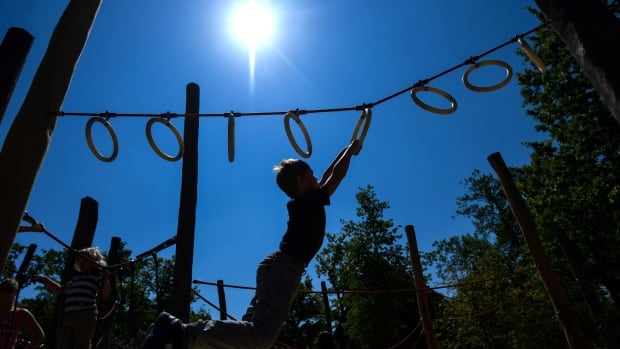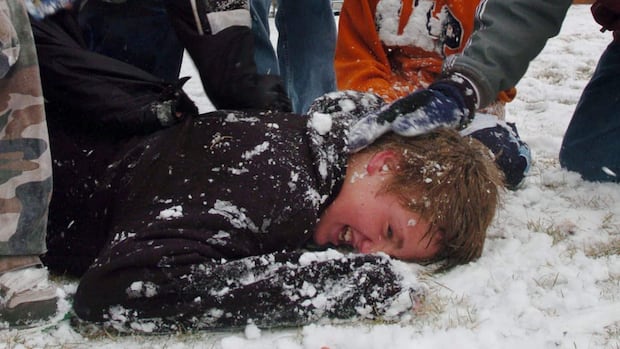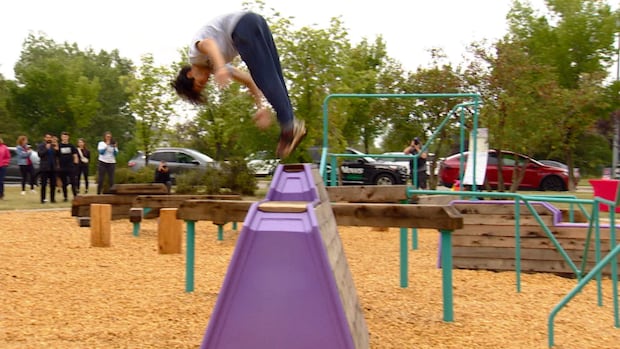Raise your hand if you’ve ever fallen off the monkey bars and hurt more than your pride.
It’s practically a childhood rite of passage. You climb, you swing, you push the limit, you miss, you cry. Maybe you dusted yourself off and limped back onto the playground. Or maybe you needed a trip to the emergency room to have a bone reset. (But if you were lucky, the cast came off in time to still enjoy some late-summer swimming).
Monkey bars, jungle gyms and playgrounds are synonymous with childhood play. They are also often the target of campaigns to reduce risk, sometimes get torn down due to safety concerns, and are often redesigned to be as injury-proof as possible.
Yet a new report from a team of anthropologists from Dartmouth College in Hanover, N.H., argues that these iconic play structures exercise a biological need passed down from apes that may be critical to childhood development. And the authors say well-intentioned efforts to mitigate their risk may, in fact, be harming kids.
In August, the authors wrote in the journal Evolution, Medicine, and Public Health that primates learn to climb at a young age to find food, stay safe from predators and to sleep in the branches of trees. So it’s little wonder that children have a natural proclivity to climb and explore.
In other words, there’s a reason they’re called monkey bars.
“Climbing is a part of us. We have been climbing for millions of years,” lead author Luke Fannin, a PhD candidate in the ecology, evolution, environment and society program at Dartmouth College, told CBC News.
Playgrounds provide a necessary challenge for children to build confidence, take calculated risks and test boundaries, Fannin said. And while children do sometimes get hurt on them, we need to strike a delicate balance between statistical risk and biological reward.
“We’re not saying that playgrounds shouldn’t be regulated,” Fannin said.
“But we need to make playgrounds as safe as necessary, not as safe as possible.”
Risk versus reward
Childhood injuries remain a major public health issue according to a 2023 report from the Public Health Agency of Canada. The report, using self-reported data from the 2019 Canadian Health Survey on Children and Youth, said unintentional injuries are the leading cause of death among Canadian children and youth.
Head injuries were the most commonly reported injuries in children, according to the report, but it also noted that children were more likely to require medical treatment for injuries related to sports and physical activity than for injuries related to playing.
Children do get injured using playground equipment — most typically, bone fractures — but kids can usually recover fully from these injuries, and overall, the risk is low, says Pamela Fuselli, the president and CEO of safety advocacy group Parachute Canada, who was not involved with the anthropological research.
Running free, taking chances and even getting hurt are essential to healthy childhood development, says the Canadian Paediatric Society. A new study says engaging in risky outdoor behaviour with peers is key to kids’ mental, physical and social health.
It’s about balance, she said — softer play surfaces and lower play structures have helped reduce injuries over the years, but “we also don’t want to take the fun out of play for all ages.”
“We need to loosen the reins a little bit,” Fuselli said.
Melanie Quilty, a mother of twin eight-year-olds in Kingston, Ont., says she agrees safety measures have swung too far.
“We have to teach them to do these dangerous things safely … teach them confidence, and to trust their instincts,” said Quilty, who works in health care.
Last year, her son, Conner, fell off the monkey bars at a park and broke his arm. He needed surgery and wore a cast for about eight weeks. But Quilty, 40, says she wasn’t nervous about him getting back on the bars when his cast came off — she was more nervous he wouldn’t want to.
“I don’t want him to be afraid his whole life,” she said.

How modern parenting plays a role
In January, the Canadian Paediatric Society (CPS) released new guidelines emphasizing the importance of unstructured outdoor play for children’s development and physical and mental health amid rising obesity, anxiety and behavioural issues.
In its guidelines, CPS argued that kids today have fewer opportunities to engage in risky outdoor play, and that’s in part because of safety measures that “have sought to prevent all play-related injuries rather than focusing on serious and fatal injuries.”
Modern parental anxiety plays into our unwillingness to let children take risks despite the developmental benefits, Fannin says.
In the last 100 years, modern parenting has shifted from a community to individual approach, he said. This creates pressure on parents to keep their own kids safe, which he describes in the paper as a “modern moral imperative.”
The community behind parkour park is hoping the facility will encourage children aged 12 and above to use it for years to come and offer an exciting outdoor activity.
Parents today are also constantly inundated with information and comparisons thanks to social media and smartphones, the U.S. Surgeon General wrote in a public health advisory earlier in September about the pressures of modern parenting.
In other words, if a child is injured in an accident on the other side of the planet, parents today are more likely to hear about it. At the same time, parents today may worry about judgment if they post a photo of their child in a cast on Instagram.
Yet, in many ways, children have never been physically safer. Crime rates have been on a downward trend since the 1990s, when many of today’s modern parents were children themselves (and may have formed some core memories of missing kids on milk cartons and stranger danger).
Today, there are laws for car seats, seat belts and bike helmets. You can put an AirTag on your kid and know where they are at any given time.
Are playgrounds too boring?
In its January recommendations, CPS cited 2011-23 data from the Canadian Hospital Injury Reporting and Prevention Program on injury types sustained during popular childhood activities. The injury rate of falls from playground equipment was 4,090 cases per 100,000 — slightly lower than the rate of injury from playing soccer.
“Some experts have attributed playground injuries to unexciting play structures,” CPS wrote in the report, explaining that structures that are too boring may lead to kids using the equipment inappropriately and take greater risks.

Jungle gyms and monkey bars are about 100 years old — patented in 1923 and 1924 by U.S. lawyer Sebastian “Ted” Hinton. Even Hinton, in his first patent, noted the link to primates.
“Climbing is the natural method of locomotion which the evolutionary predecessors of the human race were designed to practice, and is therefore almost ideally suited for children,” he wrote.
Much has changed since the earliest jungle gyms, which were, essentially, a grid of metal poles. As NPR notes, safety concerns have “softened materials and rounded edges.” Smithsonian Magazine explained there was a rise of “ultra-safe” playgrounds in the 1990s designed to minimize harm.
Fuselli, with Parachute Canada, says she thinks that the focus on making playgrounds safer has gone too far. And she knows that sentiment flies in the face of injury prevention.
“But there’s a risk to everything,” she said. And when you balance the low risk of serious injury on playgrounds with the risks of children not playing — like higher risks of obesity, and the risk of online harms — it makes sense, she added.
“You know, a child going down the street to play at the playground — the actual risk is more around the street than anything else.”





